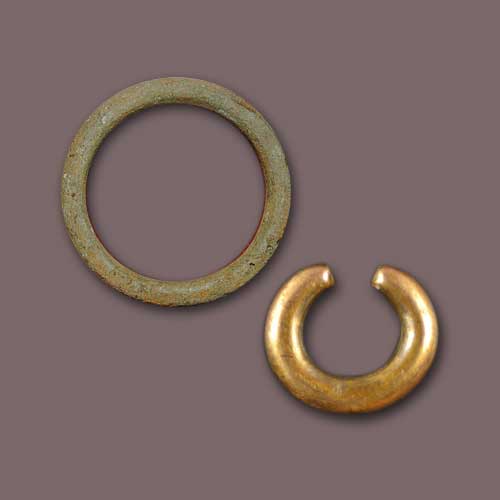Ring money of the Celtic period
2018-03-13 Tue
Ring money of Celtic period is often referred as proto-currency. They were circulated before the initiation of the cast and struck coinage in ancient Europe. These rings were produced in gold and copper metals.This ring money was the currency of Celtic tribe which they used to wear on clothes or tied together in the rope. These rings are found throughout Ireland, England, Scotland and Wales. It was a popular mode of a transaction during the Bronze Age.
The different types of ring money were plain rings, thick or thin ring, torques rings etc. The above-shown image depicts a plain gold ring with smooth edges around of 1.8 grams and 12.5 diameters. The other ring money is made of bronze found in Danube river and was circulated around 5th century BC. The bronze ring made of silver and gold was used by the Celts in trade from Ireland to the Danube region.
Some archaeologist and historian date the Celtic coinage around 800 to 500 BC, it may have circulated till 100 BC. The first ring was created in ancient Moesia (Bulgaria) in 7th Century BC of 10 mm to 40 mm in size.
The weight of this ring money varied, yet a standard weight unit was followed. The weight system followed by this rings indicate its role as proto-money. After the introduction of the different types of currency bar in the 2nd century BC, the use of the ring money died out.
To know more about British coinage click here.
Latest News
-
Panchala King Bhanumitra Copper Coin
2024-04-26 FriThe Panchala kingdom was ruled by the Mitra kings. The Mitra kings are known to issue coins and most...
-
Mahatma
2024-04-25 ThuIndia Post issued a commemorative postage stamp on #LalaHansraj, also known as Mahatma Hansraj for�...
-
Berar Mint of Muhammad Akbar
2024-04-25 ThuBerar was a kingdom located in the Deccan region, with Elichpur as its capital. It was one of the Su...
-
Janma Kalnayak of Bhagwan Mahavir
2024-04-24 WedOn 21st April 2024 which was the 2550th Janma Kalnyanak of Bhagwan Mahavir Swami, PM Modi unveile...
-
Gold Pagoda of Vijaynagar Empire King Deva Raya I
2024-04-10 WedKing Deva Raya I of the Vijayanagara Empire was a patron of Kannada literature and architecture. He ...

